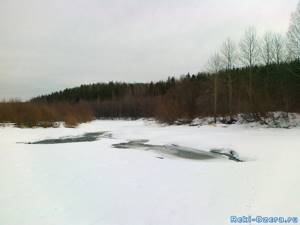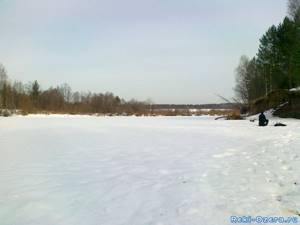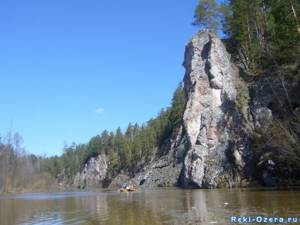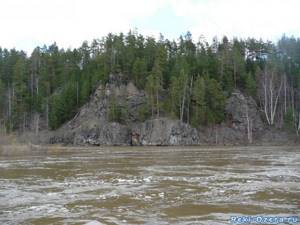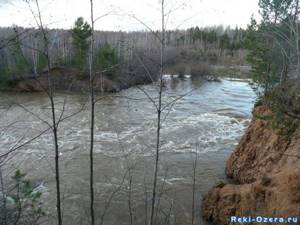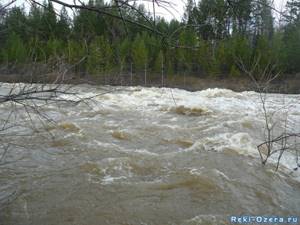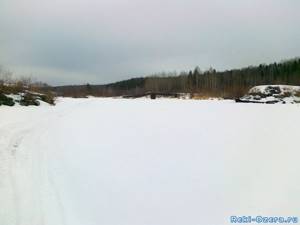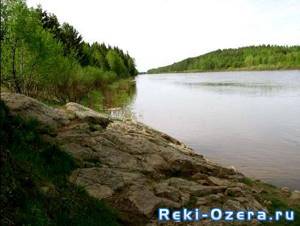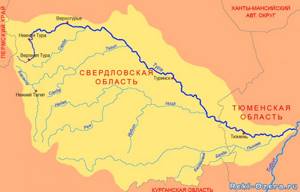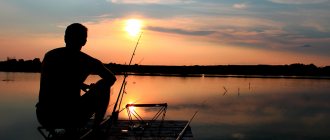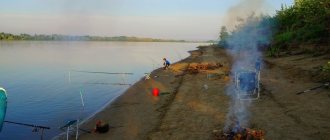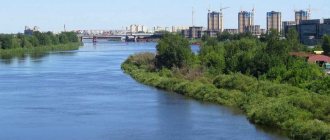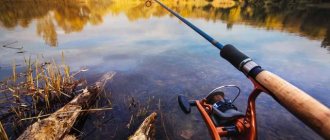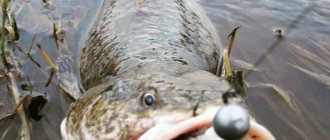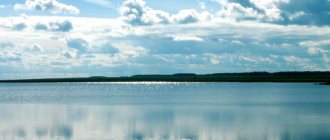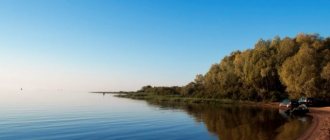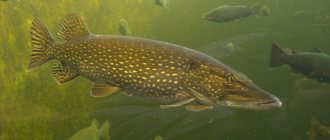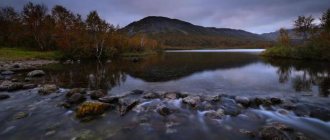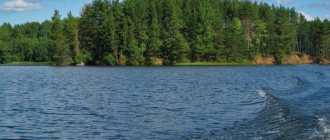Toponymy
- Other names: Tereya (Mansi), Dolgaya (near the source).
- Origin of the name: The exact origin of the name of the river is still unknown. Some local historians are inclined to believe that it is definitely Turkic - translated from Tatar the word “tura” means “house, fortress”; also the Mongolian “tour” is translated into Russian as “town, fortress” (this is associated with the fact that the current city of Tyumen, located on the banks of the river, at one time it was an important military-political center of the Western Tatars). There is an assumption of Ugric origin - from the Mansi word “tur” - “lake”, but this version looks the most dubious compared to others. It is likely that the word “tura” has more ancient roots and is associated with the peoples who inhabited the Urals before the Mansi and Tatars. This is indicated by the fact that in some languages of the Urals and Siberia there is a root “tur”, meaning “influx”.
Fishing in the Sverdlovsk region
All conditions have been created in the region to attract amateur fishermen. Every year, guide maps of water bodies suitable for fishing are published here, where convenient access routes and the species diversity of fish living in them are noted. It is allowed to catch not only fish, but also crayfish. The most common catches include pike, bream, ide, burbot, perch, whitefish, and crucian carp. When planning an independent trip, you need to choose bodies of water where free fishing is possible, and also study the features of environmental legislation. In order not to waste precious vacation time searching for a place suitable for fishing and solving organizational problems related to accommodation, food and transport, it is better to contact a fishing and tourism company, whose employees will take care of all the hassle and also suggest the best places in terms of catches .
Hydrology
- Water system: Tobol → Irtysh → Ob → Kara Sea.
- The nature of the flow: in the upper reaches - foothills, in the middle and lower reaches - flat.
- Reservoirs: Verkhneturinsky pond, Nizhneturinsky pond, Verkhotury reservoir.
- Bottom: in the upper reaches - rocky and pebble, in the middle and lower reaches - sandy, sometimes muddy.
Fishing tour in the Subpolar Urals
Get up at 8:00. Individual morning routines.
9:00 Hot breakfast (according to the menu).
Packing up the camp, leaving the two-day mooring, packing personal and general belongings, tying up the catamarans.
Start of the day's traffic.
The sixth day of the helicopter expedition is entirely devoted to rafting down the Sarma-pyt-yakha river, which is formed at the confluence of two powerful mountain rivers-arteries Pay-soim and Ruta-Yu.
The flow of the Sarma-pyt-yaha river is calm and slow.
As the height drops and moves away from the mountains, the character of the river changes, and tundra movements appear along the banks.
The rafting route along the Sarma-pyt-yakha is of interest to tourists and fishermen primarily because it passes through a rather inaccessible region of the Polar Urals.
Its distinctive feature is the abundance of diverse landscapes.
In the upper reaches of the river there are tundra, forest-tundra, mountainous terrain and the remote, impenetrable Siberian taiga .
In the middle reaches of the river, cedar and birch-spruce floodplain forests with a narrow strip of flooded meadow are quite common.
Such shores stretch for many kilometers.
The taiga forest is difficult to navigate due to the large presence of dead wood.
The goal of day 6 of the expedition is to raft as low as possible towards the confluence with the Northern Ushmanya .
While rafting down the Sarma-pyt-yakha river, the team stops for short stops to fish for the legendary king fish - polar taimen .
Each caught taimen, after a short photo session, is released back into the river without fail.
Taimen is a valuable fish listed in the Red Book of the Russian Federation and the dream of every fisherman is to see and catch red-tailed salmon - taimen - at least once.
Participants do not violate the law of the Russian Federation and are warned that any taimen caught must be released into the wild.
This is the main rule and condition in the expeditions we conduct: If you catch a taimen, you release the taimen .
All taimen must be released back into the river - its native element.
14:00 Hot lunch.
From 15:00 Continuation of rafting and fishing on the Sarma-pyt-yakha .
19:00 Arrival at an intermediate stop to set up an overnight camp.
The parking place is chosen by the guide, guided by the basic rules of rafting.
The parking lot is selected in agreement with the team, preferably opposite a rock with a hole or a pool.
As a rule, the nocturnal taimen predator stays in holes, deep reaches, barrels, and pools under steep rocks.
End of the day's rafting.
Installation of a tent, personal tents.
Collective collection of fuel for the fire and the night.
Charging batteries for photo/video equipment.
21:00 Hot dinner (according to the menu).
From 22:00, 23:00 - time for night fishing for predatory fish using special luring gear - mouse and nightwalker.
Experienced fishermen use the night time to fish for taimen, which resembles a peculiar process of night hunting - an indescribable feeling of hunting excitement - which can attract even a tourist-fisherman who is not familiar with such a fishing process.
Night on the spit of the Sarma-pyt-yakha .
Tributaries
Main article: "Tributaries of the Tura".
| Rights | Left | |
| SOURCE | ||
| 1016 | Tura | |
| 1012 | Berezovka | |
| Far Garevka | 1007 | |
| Near Garevka | 1002 | |
| Kushva | 996 | |
| Borovaya | 987 | |
| Kamenka | 977 | |
| 975 | Zavorotyayka | |
| 973 | Pavement | |
| Bolshaya Epishevka | 972 | |
| Ice | 969 | Popovka |
| 968 | Medvedka | |
| 966 | Maksimovka | |
| 963 | Sarochka | |
| 951 | Small Named | |
| 937 | Big Name | |
| 919 | Vya | |
| 911 | Is | |
| Burbot | 899 | |
| Lyalenka | 888 | |
| Talitsa | 873 | |
| Black | 867 | |
| Shaitanka | 861 | |
| Burbot | 853 | |
| Kosolmanka | 851 | |
| 828 | Aktay | |
| 818 | Kalachik | |
| 815 | Neromka | |
| Black | 808 | |
| 782 | Tavolzhanka | |
| Kazanka | 778 | |
| Salda | 777 | |
| 775 | Vogulka | |
| 761 | Puregovka | |
| 754 | Merkushinka | |
| Shaitanka | 752 | |
| 747 | Gypsy | |
| 746 | Prorva | |
| Morozovka | 744 | |
| Lipovka | 729 | |
| Lithuanian | 718 | |
| 704 | Dianovka | |
| Otradnovka | 700 | |
| Savinovka | 695 | |
| Otter | 687 | |
| Kopanka | 671 | |
| 669 | Yurmych | |
| 663 | Gypsy | |
| Tagil | 643 | |
| 616 | Sankina | |
| Konovalovka | 596 | |
| 571 | Turuzbaevka | |
| Susatka | 508 | |
| 503 | Bagyshevka | |
| 469 | Kokuzovka | |
| 448 | Taborinka | |
| Yalynka | 443 | |
| 418 | Shaitanka | |
| 358 | Saragulka | |
| 341 | Vyazovka | |
| 330 | Shaitanka | |
| 305 | Pogorelka | |
| Nitsa | 295 | |
| 269 | Tegen | |
| Lipka | 266 | |
| 246 | Ahmanka | |
| Kanyrka | 239 | |
| 143 | Coplank | |
| 106 | Aiga | |
| Pyshma | 97 | |
| 27 | Mezhnitsa | |
| MOUTH | ||
Scheme 1. Tributaries of the Tura. The numbers indicate the distance (in kilometers) from the mouth.
Geography
- Coastal landscape: in the upper reaches the river flows among small hills overgrown with coniferous and mixed forest. Here along the banks there are small swampy areas, here and there there are rocky outcrops, and periodically there are places of intensive gold mining, where the riverbed is heavily dug up by dredges. As Tura finally emerges from the mountains onto the plain, it begins to wind, forming numerous bends, branches and oxbow lakes. Here, forested banks alternate with water meadows. There are often damp places in the floodplain, and in some places there are large wetlands adjacent to the river.
- Settlements on the banks: Asian, Verkhnyaya Tura, Dachny, Malaya Imennaya, Bolshaya Imennaya, Nizhnyaya Tura, Lesnoy, Yolkino, Chaschevita, Talisman, Verkhoturye, Zakharova, Kostyleva, Ust-Salda, Bochkareva, Merkushino, Kordyukova, Belaya Glina, Vostochny, Lithuanian, Deryabino, Sankino, Zhukovskoye, New Shishkino, Lenskoye, Bushlanovo, Shurupovskoye, Toporkovo, Kokuzovo, Kazakovo, Chekunovo, Turinsk, Lugovaya, Korkinskoye, Galaktionovka, Gorodishche, Chernyshovo, Lipovskoye, Petrovo, Pushkaryovo, Sukhanova, Kuminovskoye, Barbashina, Tomilova , Sladkovskoye, Makuy, Andronovo, Turinskaya Sloboda, Krasny Yar, Timofevo, Zhiryakovo, Ust-Nitsinskoye, Golysheva, Yolkina, Lipchinskoye, Burmakina, Rechkina, Salairka, Konyashina, Kamenka, Kulakovo, Lugovoe, Tyumen, Yar, Parenkina, Subbotina, Malkovo , Esaulova, Kaskara, Chikcha, Yakushi, Borki, Krivodanova, Shcherbak, Sozonovo, Motushi, Dubrovnoye, Vesyoly, Pokrovskoye
Source
- Coordinates: 58°23′23″ N. latitude, 59°20′53″ e. d.
- Altitude above sea level: 416 m.
- Topographical landmark: the eastern slopes of the Middle Urals - 5 km east of Mount Podpora.
Estuary
- Coordinates: 57°12′22″ N. latitude, 67°00′29″ e. d.
- Height above sea level: 42.2 m.
- Location: Tobol River - left bank 260 km from its mouth.
Territorial location
- COUNTRY: RF . Region: Sverdlovsk region . Districts: Alapaevsky, Verkhotursky, the city of Verkhnyaya Tura, Krasnouralsky, Kushvinsky, Lesnoy, Nizhneturinsky, Slobodo-Turinsky, Turinsky.
- Districts: Tyumen city, Tyumensky, Yarkovsky.
Interactive map
Description of the reservoir
Tura is a large river, the second longest in the Sverdlovsk region after the river. Tavda. It is a left tributary of the Tobol and belongs to the Ob basin. Has the following characteristics:
- the length of the channel is 1030 km;
- The drainage basin area is 80,400 square meters. km;
- water consumption 202.7 cubic meters. meters per second;
- The slope of the river is directed to the East.
The Tura River originates from several springs flowing on the eastern slope of the Main Ural Range. They are located about 4 km southwest of the Uralsky Ridge railway station. It flows into the Tobol 260 km from its mouth.
In the upper reaches to the city of Verkhoturye, the river has a mountainous character, with a narrow valley, high steep banks, which are covered with mixed forest. There are many rocky rifts and rapids along the riverbed. The depths are insignificant, rarely exceeding 1 meter. The current speed is decent, 2–2.5 m/s.
Tura is an important body of water in the Sverdlovsk region
After Verkhoturye the valley and the river bed widens. Tura becomes calmer. The average current speed is about 1.5 m/s. There are still quite a few rapids and rifts in this area, and there are shallows and beaches giving way to stretches. Depths range from 0.5 to 3.5 meters. Sandy-silty soils predominate.
For reference! The middle reaches of the Tura are suitable for timber rafting and small-scale shipping, as well as water tourism.
In the lower reaches, from the village of Turinsk to the very mouth, the river has a typical flat character. The current speed ranges from 0.7 to 1.5 m/s, depths vary from 2 to 16 meters. The soils are predominantly sedimentary sandy loam. Numerous branches appear from the main channel.
Food tours are snow and rain. It freezes by mid-November and opens in the first half of April. The flood is prolonged with a decent rise in the water level, which reaches 6–7 meters. By the end of June the river returns to its banks. Low water occurs in the second half of July - early August.

There are many rifts and rapids in the upper reaches of the Tura
The Tura River basin is asymmetrical. The right side is almost three times larger in area than the left. Main tributaries:
- Pyshma;
- Nitsa;
- Tagil;
- Salda;
- Is;
- Aktai.
The Tura River basin is well studied. Deposits of copper, iron ore, gold and platinum have been discovered within its boundaries. It provides household and industrial water supply to the Sverdlovsk region. It is navigable at 635 km from the mouth. The cities of Tyumen, Turinsk, Verkhoturye, Nizhnyaya Tura, and Verkhnyaya Tura were founded on the banks of the reservoir.
Alloy
- Route: The most interesting section for rafting is from Nizhnyaya Tura to Verkhoturye. Here the river exhibits a more mountainous character: along its banks there are often rocky outcrops, and in the riverbed there are rapids, including quite complex ones (category 3 during floods). In the upper section of the section, the channel is a labyrinth of islands and channels - at one time, intensive gold mining was carried out here. Usually this route is followed in the spring, when there is enough water. Below Verkhoturye you can raft along the Tura not only in spring, but also in summer, but there the river shows a flat character - it winds a lot and flows quite slowly, so rafting along it is not as interesting as in places upstream.
- Difficulty category: 1.
- Obstacles: in the upper reaches - rapids, rifts.
|
|
Rocks on Tour |
|
|
Lyalinsky threshold |
Destroyed bridges on Karelino |
Tura River |
River Tura. Map |
Fishing on the Tura River: perch, pike, bream, ruff, gudgeon, roach, burbot, ide, dace, pike perch, bleak, minnow, chebak, sterlet, nelma.
In the lower reaches of the river, industrial fishing is carried out with nets. The shore is all silted, you can fall into mud up to your knees, so you shouldn’t go near the water without waders.
The Tura River is not considered a fishing river; it is usually used by local residents or visiting fishermen who come to explore the place. Fish stocks in the river have decreased due to gold mining in its upper reaches, which have been turned into a cascade of ponds. Locals often catch them with nets. Closer to Tyumen, there are more fish, but many sections of the river are leased for industrial fishing. Closer to the Tyumen region, pike perch is well caught on the river, and large pike are found near Turinskaya Sloboda. In the fall, burbot is caught on the Tour; it is very active before the freeze-up.
Direction from Yekaterinburg: Serov Distance to the nearest access point (range): 200-300 km How to get there:
There are many approaches to the river from the Yekaterinburg-Serov highway. Beautiful places and good catches at the confluence of the Tagil River and Tura. You can get there along the Alapaevsk - Verkhnyaya Sinyachikha road, then to the village. Sankino. You just have to remember that after s. The Makhnevo road is passable only in good weather. To the lower reaches there is a road from Yekaterinburg to Turinskaya Sloboda, behind which there are many approaches to the river.
The best places for amateur fishing (all routes from Tyumen):
1. Berega Tura near the village. Salairka (Tyumen district). You can get there along the Salairsky tract. At the 52nd km of the highway you need to turn towards the village. You can get to the water through the Geologist tourist center. In this place you can fish all year round: in winter - for ruffe and perch, in summer - for pike, roach, pike perch, bream, perch, dace, in the fall they catch burbot.
2. Wintering pits on Tura (within Tyumen and on the 7th km of the Starotobolsky tract) and the bank of Tura in the vicinity of the village of Chikcha (20th km of the Starotobolsky tract) in the Tyumen region abound in pike, bream, ide, roach and ruff.
3. The place where the Pyshma River flows into the Tura (55th km of the Tobolsk tract). Having reached the sign for the village of Sozonovo, you need to turn right off the highway and drive about a kilometer along the road going through the field. People come here for burbot, perch, pike, roach, bream, ide and dace.
4. The mouth of the Mezhnitsa River near the village. Pokrovskoye (80th km of the Tobolsk highway). Near the village of Pokrovskoye, you should turn right off the highway and drive to the shore along a country road. At different times of the year, pike, roach, ide, bream, perch and burbot are caught here.
5. The mouth of the Tura in the vicinity of the village of Usalka (94th km of the Tobolsk highway).
After turning from the highway to the village, you will have to travel another 11 km along a field road to the shore. All species of fish characteristic of Tura are found here. Depths: average upper/lower reaches: on reaches: 5-9 m.m. Catchment area: 80,400 km2 Tributaries: rivers Salda, Tagil, Nitsa, Pyshma, Aktai, Kamenka, Malaya Namenaya. Origins: Sverdlovsk region, near the village of Khrebet-Uralsky. Coordinates: latitude: 58°24′30.29″N (58.408415), longitude: 59°21′38.98″E (59.360829). Width in the upper/middle/lower reaches (m): 60/100/150 Average current speed (except for riffles): 1.5-2 km/h Fee: Free Comment:
If it doesn’t open, link to download the video “Lyalinsky rapids” . Click here.
See also the report “Spring rafting on the Tura River”.
Mouth: Tobol River, 260 km from the mouth, Tyumen region. Coordinates: latitude: 57°12′41.55″N (57.211542), longitude: 66°57′10.01″E (66.95278). Height difference from mouth to source: 5-15 m Settlements on the shore: Vologina, Kosolmanka, Privokzalny, Verkhoturye, Krasnogorskoye, Ust Salda, Kordyukovo, Bolotovskoye, Sonkino, Zhukovskoye, Shukhrupovskoye, Turinsk, Pushkarevo, Sladkovskoye, Turinskaya Sloboda, Ust- Nitsinskoye, Kamenka, Kulakovo, Tyumen, Chikcha Possibility of rafting: yes. Minimum length of the rafting route: 3 Maximum length of the rafting route: 68 Routes for rafting and parking:
1. Nizhnyaya Tavda village, beyond the crossing.
Road description: Excellent road. About 90 km from Tyumen. 2. Mouth of the Tura River Exit the asphalt road to the right at the village. Usalka, Yarkovsky district (Tobolsk tract, 94th km from Tyumen), then 11 km along a field road. All representatives of the ichthyofauna usual for the Tura River, in addition, single specimens of sterlet and nelma (catching is prohibited!). 3. The oxbow of the Tura River near the village of Sozonovo. 4. Tobolsk highway 55 km from Tyumen. Exit to the right from the highway, from the village, 1 km along a field road. 5. The bank of the Tura River between the villages of Chikcha and Oshkova, Tyumen district, Starotobolsky tract, 18 - 21 km from Tyumen. Exit the highway to the right, then follow the country road. 6. “The Great Siberian Way” can start from Turinsk and sail to the village of Kulakovo. The total length of the route will be 100 kilometers. Water tourists usually overcome them in 4-5 days. Parking lots: 1. In front of the village of Gorodishche there is a flat shore, which is difficult to land on. You can make a parking lot near the village of Mitrofanovka, but there is a danger of meeting with locals. 2. You can stop for the night opposite the village of Sladkovskoye 3. Opposite the village of Andronovo there is a beautiful beach 4. Parking lot near Turinskaya Sloboda, opposite the village there is a beautiful green cape. 5. The most beautiful place is Krasny Yar, here the river makes a sharp bend, on the left bank there is a steep cliff of 4-5 meters, on the right there are sandy beaches. 6. Parking can be done near the villages of Burmantovo or Rechkino. Lakes and reservoirs along the way:
Nizhneturinskoye reservoir, Verkhneturinskoye reservoir, Verkhoturinskoye reservoir.
Features:
Left tributary of the Tobol River (Irtysh basin). The Verkhoturskaya hydroelectric power station is located on Tura. Tura is the main source of water intake for Tyumen's water supply. Some sections of the river are secretly leased. The riverbed of the Tura is winding and has numerous rapids. The shallow depth here often reaches 1 m. The river flows in a south-eastern direction.
Attractions
Verkhoturye

Verkhoturye is one of the oldest cities in Russia, located beyond the Ural Range, the oldest city in the Sverdlovsk region, which is also a regional religious center. It is famous for its architectural monuments of the 17th-20th centuries, including the smallest Kremlin in Russia with the Trinity Cathedral, the Nikolaevsky Monastery, and the Pokrovsky Monastery.
Fishing on the Tura River
- Types of fish: ruff
- perch
- zander
- Demoiselle minnow
- gudgeon
- bleak
- roach
- dace
- ide
- bream
- pike
- nelma
- burbot
- sterlet
Fishing spots
Conventionally, the river can be divided into 3 sections:
- The upper section is from the source to Verkhoturye. Here the river is considered sparsely fished - this was facilitated by gold mining by dredging and poaching flourishing in those parts; the most interesting fishing is possible only in reservoirs built on the river. In Tura itself, fish are also caught, but infrequently and mostly small. Most often, the catches include roach, perch, dace, and roaches. In the cold season, catching burbot on donkeys is quite common here.
- The middle section is from Verkhoturye and approximately to the border of the Sverdlovsk and Tyumen regions. As sufficient depths begin to appear on the river (especially after the confluence with Tagil), fishing becomes more interesting. In the middle reaches, fish species such as pike perch and bream appear. There are noticeably more other fish, and the average size of caught specimens increases. Places from Turinskaya Sloboda and below are famous for large pike. Also, in the middle reaches the river is most interesting in terms of burbot fishing.
- The lower section is from the border of the Sverdlovsk and Tyumen regions and to the mouth. The most interesting section of the river, highly revered by local fishermen. The ichthyofauna of this area is replenished with two new species - nelma and sterlet - these fish are found sporadically, are listed in the Red Book and are prohibited from catching. The main catches of fishermen here are roach (including quite decent ones), perch, pike perch (especially in the vicinity of Tyumen), pike, and bream. There are a lot of ruff and bleak, and dace is often found. Getting to these places is not difficult - from Turinsk to Tyumen, there is an asphalt road to the right of the river - in some places it comes close to the river, and there are also many exits from it to the shore.
Fishing Features
A fisherman going to the lower reaches of the Tura River should take into account that industrial fishing is carried out there with nets, and some sections of the riverbed are at the disposal of tenants.
Who inhabits
Tura is a fish reservoir in the Sverdlovsk and Tyumen regions, in which quite large fish are found, especially in its lower reaches. It is in the lower reaches that there is a high probability of encountering a trophy specimen that can deliver a lot of memorable impressions.
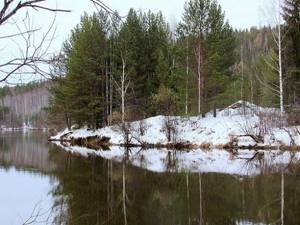
The main inhabitants of Tura are pike, bream, perch, chebak and burbot
A variety of fish are found in the Tura River:
- bream;
- ruff;
- perch;
- chebak;
- pike;
- burbot;
- ide;
- dace.
There are a lot of pike perch in the lower reaches. There are bleak, minnow and minnow. There is a sterlet.
